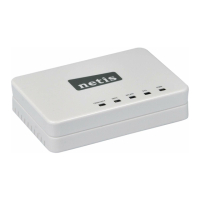
Do you have a question about the Netis WF-2403 and is the answer not in the manual?
| VPN support | PPTP, L2TP, IPSEC |
|---|---|
| Ethernet LAN | Yes |
| Cabling technology | 10/100Base-T(X) |
| Networking standards | IEEE 802.11b, IEEE 802.11g, IEEE 802.11n, IEEE 802.3, IEEE 802.3u |
| Ethernet LAN data rates | 10, 100 Mbit/s |
| Ethernet LAN interface type | Fast Ethernet |
| Wi-Fi standards | 802.11b, 802.11g, Wi-Fi 4 (802.11n) |
| Top Wi-Fi standard | Wi-Fi 4 (802.11n) |
| WLAN data transfer rate (max) | 300 Mbit/s |
| USB version | 2.0 |
| Rack mounting | No |
| Frequency range | 2.4 - 2.4835 GHz |
| USB ports quantity | 1 |
| DHCP client | - |
| Security algorithms | 128-bit WEP, 64-bit WEP, SSID, WPA-PSK, WPA2-PSK |
| Certification | FCC, CE |
| Storage temperature (T-T) | -30 - 80 °C |
| Operating temperature (T-T) | -10 - 70 °C |
| Storage relative humidity (H-H) | 5 - 95 % |
| Operating relative humidity (H-H) | 10 - 90 % |
| Product color | White |
| LED indicators | Activity, Link, Power, WLAN |
| Cables included | LAN (RJ-45), USB |
| Weight | - g |
|---|
Statement on compliance with FCC rules for Class B digital devices.
Compliance with FCC RF radiation exposure limits for uncontrolled environments.
Lists items included in the router package.
Provides contact information for customer support.
Describes the router's purpose, key features, and technical specifications.
Specifies operating conditions such as temperature and humidity.
Lists prerequisites and identifies router components and LEDs.
Steps to reset the router to its default settings.
Guide for setting up the router in AP-Router, Client, or AP modes.
Accessing the router's web interface and viewing system status.
Configuring network parameters, wireless settings, and security.
Configuration for Wi-Fi Protected Setup for secure wireless connections.
Advanced wireless options including channel, width, and preamble.
Configuring WPS for secure connections and viewing wireless client statistics.
Configuring DHCP server, clients, and IP address reservation.
Setting up port forwarding, DMZ, and port triggering for applications.
Controlling network access via IP, MAC, and domain filtering.
Manually configuring network routes and traffic prioritization.
Managing firmware, time, passwords, logs, and remote access.
Setting up dynamic domain name services for remote access.
Updating firmware and changing router passwords.
Using WOL, viewing logs, and rebooting the router.
Configuring remote access and restoring factory settings.
Backing up and restoring router configuration.
Accessing the web interface and connecting to the internet in Client mode.
Managing status, network, DHCP, and system tools in Client mode.
Accessing the web interface and configuring wireless settings in AP mode.
Configuring DHCP and using system tools in AP mode.
About information for AP mode.
Solutions for problems accessing the utility or connecting to the internet.
Steps for password recovery and troubleshooting modem connections.
Resolving issues with wireless client communication.